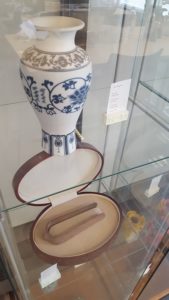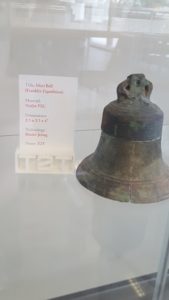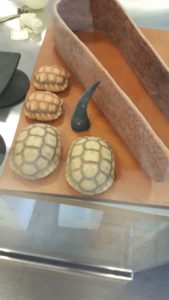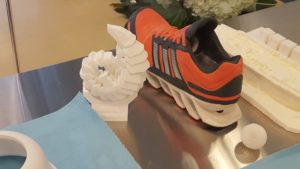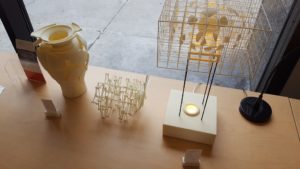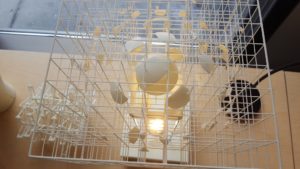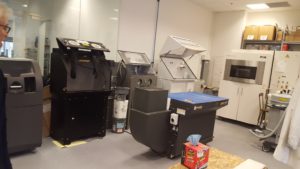 Toronto-based Think2Thing is no longer a stranger to 3D printing technology, but the story had to start somewhere. For the founding team, this story’s “once upon a time” was October 2014, where in a far-off kingdom (the United Kingdom, that is), a 3D printing conference in London lit a new flame of interest. The quest to form a new business faced challenges more cerebral than fire-breathing, and the hero of our tale is technology — and those who can wield it to great effect.
Toronto-based Think2Thing is no longer a stranger to 3D printing technology, but the story had to start somewhere. For the founding team, this story’s “once upon a time” was October 2014, where in a far-off kingdom (the United Kingdom, that is), a 3D printing conference in London lit a new flame of interest. The quest to form a new business faced challenges more cerebral than fire-breathing, and the hero of our tale is technology — and those who can wield it to great effect.
“Think2Thing was born out of a conversation,” Founding Partner and Design Director David Didur said at last week’s Be3D conference. “It started with a simple question: ‘What do you know about 3D printing?’ I said, ‘A bit, but I hadn’t kept up with it.’ At the London 3D printing conference, we recognized the power and clearly disruptive nature. We came back and started Think2Thing and got equipment set up… We weren’t sure yet what the business plan we, we really wanted to work with business leaders and creative minds…. We thought this approach would be fun and also lead to business possibilities. The most obvious answer was through education, like we had experienced over those four days in London.”
The day after attending the Be3D Think Forward conference, I visited Think2Thing in its Toronto HQ, located near both the city’s arts district and the campus of partner Ryerson University, which worked with T2T on the Be3D event. Sitting down with Didur in the epicenter of the company’s operations, I enjoyed the opportunity to learn more about their start and their ethos as we chatted over coffee. Surrounded by some of Didur’s remarkable art, brought to life in 3D printed form, as well as the disassembled letters that had adorned the stage the day before with a large-scale THINK FORWARD, it was clear that this office houses intense creativity — and drive. Founding Partner and Operations Director Lisa Cancellato is to thank for much of the order behind the artistic vision, Didur made sure to point out, as keeping artistic personalities on track can be a thankless job (but not at T2T).
It wasn’t just vision that came across as I talked with T2T, but a real sense of discovery in finding the right direction to take visionary approaches, to truly embrace 3D technologies and unleash their potential. Going back to the conference that started the team on their T2T journey, Didur remarked on the value of such events.
“Everyone was there, all the players identified, everyone was there (e.g., Jonathan Rowley from Digits2Widgets, Bre Pettis, etc.), and I was so impressed with the quality of the discourse and the workshops and lectures — it had this tight beautiful trade show component, this small intimate fantastic thing over 4-5 days, we left just completely turned on, we loved the speakers, great discourse with the speakers afterward,” Didur told me.
“It was really the London show that helped to make a commitment to starting Think2Thing, recognizing the power of the tools, the disruptive nature of the technology. It wasn’t about creating a service bureau, we wanted to create a lab that would work with great thinkers and innovators and find new applications for the technology, so we needed to learn it first. The group of us come from a craft background, have a studio practice that comes from fine craftsmanship, and applied it to these tools and the way we make things. I think the technology in our hands, we do things with it other people can’t because of our backgrounds because of what we’ve learned and what we’ve developed. A lot of time and energy went into color management, I think we do it better than almost anyone. There’s no one that would print (my work over there) the way we do; Shapeways would say, no, we’re not touching that.”
 Technology conferences can have major effects, as so many great minds come together in a shared space, sharing information and dreams as well as sparking others. During the Be3D event, Co-Founder and Director Edward Burtynsky added to Didur’s explanation of their genesis:
Technology conferences can have major effects, as so many great minds come together in a shared space, sharing information and dreams as well as sparking others. During the Be3D event, Co-Founder and Director Edward Burtynsky added to Didur’s explanation of their genesis:
“I became interested in 3D shooting in Sudbury on one of my shoots back in the ‘80s, they were showing laser sintering, stereolithography out of this vat, and it was reducing the design cycle. I was thinking, that’s the future. From that moment, I thought there was something in 3D. I studied tool and die making, became a photographer; how do I move from being a photographer and move into 3D? I thought photography was part of that 3D story. … We established Think2Thing… and it was a big adventure, and it is still a big adventure. Be3D was our first conference, Think Forward is our second conference, as we seek to bring creative minds to this technology, mix and mingle and exchange ideas and hopefully turn Toronto into a 3D center.”
 The first Be3D conference was held in 2015, the first 3D printing conference in Toronto. That inaugural event, Didur noted, also had an exhibition element to it, but moving to the next event, the team decided to “keep the commercial out of it” and focus on the people behind 3D technologies and how they can “Think Forward” — and how they can help that come to fruition.
The first Be3D conference was held in 2015, the first 3D printing conference in Toronto. That inaugural event, Didur noted, also had an exhibition element to it, but moving to the next event, the team decided to “keep the commercial out of it” and focus on the people behind 3D technologies and how they can “Think Forward” — and how they can help that come to fruition.
“Be3D is a call to arms, a command: be three-dimensional!” Didur enthused. “We created that brand to do the conference and further created it for our innovation fund. The philanthropic work we do, the initiative works we do, the grants we raise money for and give and distribute, it falls under that category. It’s a Think2Thing brand. We’ve invited Ryerson to work on what we do, they work with us under this brand; Be3D is exclusive to Think2Thing. The first innovation fund we raised $100,000 with the help of Ryerson, the Brookfield Foundation, a private donor, and the director of the National Gallery of Canada to choose an artist so we were at arm’s length, and we gave them each $50,000 to unlock potential, look at technology in a new way, find new ways to use the technology. We’re working with those artists now. We’re doing fashion now, we’ve chosen one of the two winners alerady. We’re excited about that, we’ll be expanding that out to engineering, to medical, to industrial design. These are some of the initiatives we’re working on as a company, to educate, to innovate. We think it will also reveal some interesting business opportunities as well, for what we’ve learned from this.”
The Be3D Innovation Fund has been working with two artists since their selection last spring, and Didur and team were enthusiastic about the ability to move forward with the next projects to come from the Innovation Fund and what that will continue to mean for developing talent in Canada, providing perhaps the first direct access to 3D technologies for the selected winners.
Additionally important to the team at T2T are the concepts of education and innovation, and just what defines each. Working definitions are important to T2T, as Didur came back to what each idea he presented meant, from what the company itself is to how education is more about how to think than what to know, and the line between innovation and creativity as it relates to engineers.
“We get back to the definition of us; Thing2Thing is not so much a service bureau, it’s like a think tank but it’s not, we still have to make a living. We use the technology in a number of ways, from heritage and culture to creating artifacts — copies of artifacts — to purely artistic projects. Also to aid in the product development side of the business, we help companies realize a project, go through the prototyping stage and into marketing. Most of what we do is under nondisclosure, so it’s hard to talk about. There’s a wide range of what we do here, 3D tech is at the core of it all, 3D printing, scanning, computer modeling,” Didur said.
 3D technologies are the key to understanding T2T, as Didur goes to the basics: “All 3D technology tools start with the asset — with the digital file.” That file is at the heart of creations made in this space, and is a pathway to creation. Didur noted the path from photography to sculpture, as 2D photographs can take to the third dimension with 3D scanners to create something new. Discussing the project of recreating the Erebus bell, Didur said he “didn’t want to call it a replica or a reproduction, so I called it a portrait. Ed (Burtynsky) took that portrait statement and turned it into photography 3.0.”
3D technologies are the key to understanding T2T, as Didur goes to the basics: “All 3D technology tools start with the asset — with the digital file.” That file is at the heart of creations made in this space, and is a pathway to creation. Didur noted the path from photography to sculpture, as 2D photographs can take to the third dimension with 3D scanners to create something new. Discussing the project of recreating the Erebus bell, Didur said he “didn’t want to call it a replica or a reproduction, so I called it a portrait. Ed (Burtynsky) took that portrait statement and turned it into photography 3.0.”
“Scanning is mainly a photographic process, adding another dimension — adding that Z to it,” Didur told me. “The 2D experience in a photograph moves to that 3D experience with a model, which then translates directly into 3D printing. Looking at the path from photography to sculpture, taking 2D photographs to the third dimension with scanners, creates a direct path to a 3D model and thus to a 3D print.”
 Think2Thing has been working in partnership with Ryerson University for some time, as the nearby school — it’s about a five-minute walk from the T2T office to a design studio at RU — and T2T offer one another additional resources.
Think2Thing has been working in partnership with Ryerson University for some time, as the nearby school — it’s about a five-minute walk from the T2T office to a design studio at RU — and T2T offer one another additional resources.
“It’s an interesting relationship, it’s an association in that Think2Thing is a private corporation,” Didur explained. “We work with Ryerson on a number of initiatives, it’s all quite experimental. We’re defining ‘relationship’, with what each of us brings to the table. How our influence affects their culture; for Ryerson to have access to the kind of resources we have is beneficial. Researchers don’t always understand product development… we work with that end of Ryerson and create a situation here where they’re working with us here in our environment and are also exposed to the commercial world, some instances where we’ll have a commercial request for something, let’s say a medical device, and there’s a researcher already working on that, and we’re able to connect the dots there and create something that’s great for everyone there.
I think Ryerson is really thinking forward and trying to understand the ever-evolving landscape of education and what that means. I think about when I went to school, and how that compares: we all have all the knowledge of mankind in our pocket — you can pull out your phone from your pocket and Google anything you want to know. Education becomes more about developing how you think, styles of thinking. Ryerson is interesting because polytech is in their DNA, they were a polytechnic institution before they were a university. They have this history of making things. That in conjunction with higher academic initiatives and theoretical academia having that polytechnic DNA really creates an innovative environment.”
 Think2Thing is not afraid to think outside the box, nor to encourage others to do so. Innovation is important to the company, as well as regularly examining their own projects and capabilities. While others may see certain projects as fairly straightforward, Didur points out the necessity of creativity in every endeavor:
Think2Thing is not afraid to think outside the box, nor to encourage others to do so. Innovation is important to the company, as well as regularly examining their own projects and capabilities. While others may see certain projects as fairly straightforward, Didur points out the necessity of creativity in every endeavor:
“And of course creativity is essential in everything – in design, in science, in engineering – or nothing changes, there’s no contribution. Especially in engineering,” he said.
“We come against that – we’re engineers – in that it’s kind of blockhead thinking, it’s about math, protecting the client, safety, structure, to do something great you have to get out of that rigid way of thinking which up until now has been important because engineering is about quality and safety and liability. Now building something, you need an engineering report and you know it’ll be fine because the principles you’re using are tried and true. With new technology we look at when we’re designing and adapting from nature, to cellular structure to create strength, it’s kind of a new frontier in engineering, it’s totally changed. It’s so interesting for what Greg Lynn was saying at the conference with using AR to look at air flow and stress and coefficients of expansion and all of the engineering issues in the designing of a boat. These new software tools are really great to take engineering out of really stiff blockhead thinking, into opening it up and expanding things out.”
Visiting Think2Thing was an eye-opening experience for me, and not just because they’re generous with coffee. The team at work in the Toronto office are truly focused in on what they’re doing, and are working often with a variety of collaborators and partners on all kinds of projects; in my few hours there, I saw several groups come in for meetings, was able to see some 3D printed projects almost ready to ship off to their top-secret (well, NDA-secret) destinations, and the attention to detail paid in each instance. The office was quite busy, and the lab space well occupied with a variety of machines and projects in various states of readiness. I look forward to keeping up with the progress at T2T as they strive to make Toronto a center of innovation in 3D technologies — which, judging by the hard work visible in just two days last week, doesn’t seem a far-fetched goal at all.
Subscribe to Our Email Newsletter
Stay up-to-date on all the latest news from the 3D printing industry and receive information and offers from third party vendors.
You May Also Like
3D Printing News Briefs, April 13, 2024: Robotics, Orthotics, & Hypersonics
In 3D Printing News Briefs today, we’re focusing first on robotics, as Carnegie Mellon University’s new Robotics Innovation Center will house several community outreach programs, and Ugogo3D is now working...
Rail Giant Alstom Saves $15M with 3D Printing Automation Software 3D Spark
3D Spark has entered into a three-year deal with the rail giant Alstom. Alstom, a transport behemoth with annual revenues of $16 billion, specializes in the manufacture of trains, trams,...
Meltio Expands Global Reach with New Partnerships in the Americas and Europe
Spanish 3D printing manufacturer Meltio has expanded its sales network across the globe. With the addition of three new partners in the United States, Brazil, Argentina, and Italy, Meltio aims...
3D Printing Webinar and Event Roundup: April 7, 2024
Webinars and events in the 3D printing industry are picking back up this week! Sea-Air-Space is coming to Maryland, and SAE International is sponsoring a 3D Systems webinar about 3D...





